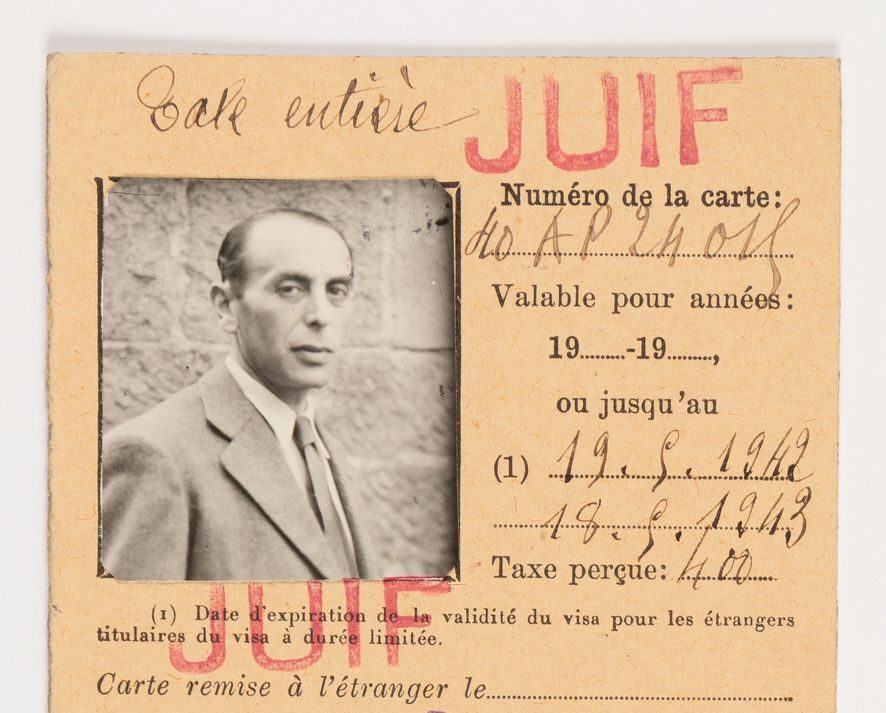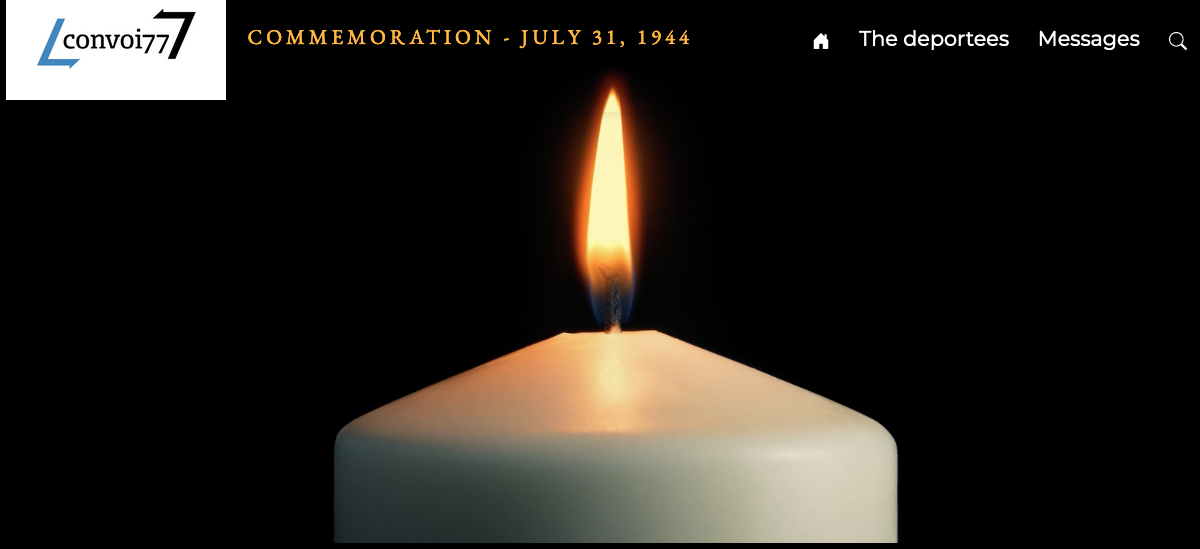Ernest SCHMELZER
Introduction
On January 30, 1933, the German President Paul von Hindenburg appointed Adolf Hitler, the leader of the NSDAP (Nationalsozialistische Deutsche Arbeiterpartei) party, to lead the country. On the night of February 27 to 28, 1933, the Reichstag, the seat of the German Parliament in Berlin, burned down, spreading a climate of fear throughout the country. The Nazis turned the incident to their own political advantage; the population was afraid that the political establishment would become more rigid. Thousands of Jews fled Germany, and then Austria. The Nazi authorities also “encouraged” them to leave. This marked the first large-scale migration of Jews to France, where they hoped to escape the Nazi persecution that was already starting to emerge.
I) Ernst’s life before the war
Ernst, whose full name was Ernst Joseph Israël Schmelzer, was born at 7 a.m. on April 3, 1899, in Börsborn, Rheinland-Pfalz, Germany. His mother’s maiden name was Jeanne Abraham until she married Gustav Schmelzer, Ernst’s father. Ernst grew up with his parents in Germany, and is believed to have fought for the French army during the First World War.
According to records from the Puy de Dôme prefecture, Ernst arrived in France on August 19, 1933 with a valid passport, although his wife, Marthe, only arrived the following year, in August 1934.
On December 1, 1934, according to French trade records, Ernst, together with Max Bier and Gunter Bernheim, set up a company called Relima. They did this in response to the French government’s tightening of sanctions on refugees arriving from Germany, who were required to contribute to the French economy or risk deportation. The company’s head office was at 3 Boulevard de Belleville in Paris.
On February 9, 1939, the Seine Prefecture of Police issued Ernst with a non-worker foreigner’s identity card, no. 38EK49327, which was valid until March 13, 1942. HIs identity cards, which were issued by the Police Headquarters, all date from the year in which he arrived in France.
Before the war, Ernst lived in the 17th district of Paris.
II) During the war
On September 1, 1939, although Germany had not officially declared war, the German army invaded Poland on the pretext that Polish troops had been “guilty of provocation” along the German-Polish border. The conflict escalated as the various European powers and their colonies successively joined in the war. The fighting spread to France, where the Germans use their “Blitzkrieg” (lightning war) tactic from September 3, 1939 to June 22, 1940, the date on which Philippe Pétain, who had become the leader of the French government six days earlier, signed the armistice in Rethondes, a village near Compiègne, northeast of Paris. On October 24, 1940, when Hitler and Pétain shook hands in Montoire-sur-la-Loire, in the Loir et Cher department, France began collaborating with Nazi Germany.
Ernst was sent to the Morand camp in Boghari, Algeria, in February 1940. This was a French military internment camp in what was then French Algeria. As soon as war was declared in September 1939, citizens of “enemy countries” who had sought refuge in France were interned on grounds of their nationality. In those days, being a political refugee did not override the criterion of being from an enemy country. The people interned for this reason included numerous anti-Nazi intellectuals and Jews who had fled persecution. From September 1940 onwards, some 40,000 foreigners, including many Spanish refugees who had refused to join the Foreign Legion, were forced to work in what were termed “foreign workers” groups. Living conditions in the work camps were abysmal. The prisoners had to endure the heat of the Algerian desert as well as poor sanitary conditions and a severe lack of food and water. During his time there, Ernst worked as a military contractor. In the Morand camp, young military contractors were trained, took part in surveillance and policing missions, and some prepared for broader military activities, all amid rising international friction.
Marthe, who had been living at 50 avenue Anatole France in Royat, in the Puy-de-Dôme department of France since August 13, 1940, requested that her husband be brought back to France. Ernst too was keen to rejoin his wife.
In a letter dated May 8, 1941, the prefect of the Puy de Dôme department stated that he had no objection to Marthe’s request. However, before her husband could return to France, Marthe had to prove that she had sufficient income and in particular the financial resources to support him in her home in Royat. In addition, Ernst himself had 20,000 francs, which was enough to live on after he was demobilized in Algeria. Lastly, the Governor General of Algeria did not object to Ernst’s returning to France, as there had been no negative comments about his conduct. His exemplary behavior resulted in his being reunited with his wife on June 17, 1941.
On February 4, 1942, an official statement introduced a series of measures to round up foreigners. One of these was to assemble foreigners at Châteauneuf-les-Bains, including Ernst and Marthe Schmelzer. In addition, the local military police chief was ordered to take away their residence permits and notify them in writing that they had to move to Châteauneuf-les-Bains within sixteen days. Ernst and Marthe were sent to Châteauneuf for a number of reasons: they were married, had no children, did not work and had unverifiable assets of 30,000 francs. They moved into an apartment building owned by a Mr. Faugère in the hamlet of Lavaux, just south of the town.
On July 2, 1944, the Gestapo (the Nazi political police) arrested the couple in Châteauneuf-les-Bains. Depending on the source, the reason for the arrest was either that they produced false identity documents and/or they were arrested during a round-up aimed at deporting Jewish people to concentration or extermination camps. Maurice Berhuil, who lived at 49 Rue du Landy in Clichy, reportedly witnessed the arrest. The couple were then held in Montluçon prison until July 12, 1944. They were then transferred to Drancy camp, where they arrived on either July 13 or 15, depending on the source. Ernst was assigned the serial number 25140. On July 31, the couple were deported on Convoy 77, the last major transport of Jews to the Auschwitz-Birkenau concentration camp and killing center. Marthe died during the journey. Ernst arrived alone among the crowd on the night of August 3, 1944. During the selection process, he was sent into the camp to work, and had the number “B 3916” forcibly tattooed on his arm as soon as he arrived. His work probably involved digging and earth moving, which was exhausting and for the most part pointless. From June 2 through July 4, 1944, according to SS documents, which recorded admissions and discharges from Block 21, the Auschwitz I “hospital”, Ernst was hospitalized at the age of 45 with pneumonia and digestive problems. He then suffered from hernias and post-operative appendicitis, exacerbated by the hard labor. Again according to Nazi records, Ernst was operated on for a lung abscess on October 14, 1944 in block 21, the last place in which he was imprisoned, and for a double hernia on January 3, 1945. The Red Army liberated the Auschwitz-Birkenau camp on January 27, 1945, but Ernst remained there until May 2, 1945, probably because the torture he had endured over the previous five months had almost destroyed him.
Ernst made the long journey back to France with the help of the Polish, American and French authorities. Having left Auschwitz on May 2, he passed through Odessa on May 7, and was finally repatriated to Marseille, on the south coast of France, on July 7, 1945. According to the Victims of Contemporary Conflicts Archives Division of the Ministry of French Defense Historical Service, the French authorities at the reception center in Marseille issued him an identity card, No. 1 254 851. He then returned to Paris, where by December 4, 1945, he was living at 11 rue de Moussy, in the 4th district.
III) After the war
When the war and his internment were finally over, and following the death of his first wife, Marthe Schmelzer, Ernest gradually made a new life for himself. On July 22, 1950, he married Johanna Schmelzer-Sachs, née Steinitz. On January 15, 1959, he received a compensation payment for the cruelty he had undergone both before and during the war. The authorities paid him payment No. 9720 of 8,400 francs, which is the equivalent of around 17,500 dollars in today’s money. In February 1959, Ernest moved to an apartment at 19 boulevard de la Somme, in the 17th district of Paris, where he lived there until his death, on April 28, 1985.
Conclusion
The Jewish community in Börborn has all but disappeared now. A Jewish cemetery and links with families who fled to the USA are the only remaining traces of the once flourishing Jewish population. The Jewish Museum in Steinbach am Glan, which celebrated Jewish culture before the Second World War, is quiet these days, perhaps reflecting a lack of interest in Jewish history and the Jewish diaspora, despite the fact that they were such an integral part of German society in the past.


 Français
Français Polski
Polski










